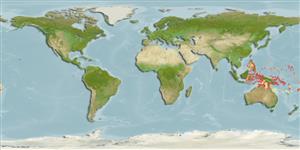>
Eupercaria/misc (Various families in series Eupercaria) >
Nemipteridae (Threadfin breams, Whiptail breams)
Etymology: Scolopsis: Name from the Greek masculine noun 'skolos' meaning 'thorn' and suffix '-opsis' (from Greek feminine n. 'opsis' meaning 'aspect', 'appearance') meaning ‘thorny appearance’ presumably referring to 'les dentelures de la préopercule, en ont aussi, et même d'épineuses, aux sous-orbitaires' mentioned by Cuvier (1814) in his designation of the genus. Name ending in -'opsis' are treated as feminine according to ICZN 1999: Article 30.1.2 (Ref. 130620).
More on author: Cuvier.
Environment: milieu / climate zone / depth range / distribution range
Ecología
marino asociado a arrecife; rango de profundidad ? - 35 m (Ref. 90102). Tropical; 19°N - 23°S, 115°E - 176°W
Western Pacific: Eastern Indonesia, Solomon Islands, Santa Cruz Islands and Fiji. This species closely resembles Scolopsis monogramma, and the two species have been previously confused.
Tamaño / Peso / Age
Maturity: Lm ? range ? - ? cm
Max length : 35.0 cm SL macho / no sexado; (Ref. 48635); common length : 20.0 cm SL macho / no sexado; (Ref. 3810)
Espinas dorsales (total) : 10; Radios blandos dorsales (total) : 9; Espinas anales: 3; Radios blandos anales: 7. Head scales reaching forward to or just behind level of anterior margin of eye. A small naked area on temporal region behind eye. Lower limb of preopercle scaly. Antrorse (forward-directed) suborbital spine absent. Pelvic fins long, reaching to or beyond level of anus. Upper lobe of caudal fin a little longer then lower lobe. Lobes produced to form filamentous extensions in larger specimens. Color: Upper body bluish, white below. Sides are also bluish. Scales on body with yellow centers forming horizontal lines above lateral line and diagonal lines below. A pinkish-brown stripe from behind eye, arching on back beneath lateral line and terminating behind tip of pectoral fin. Four blue stripes on head.
Inhabits coastal and lagoon waters, on sand rubble bottoms close to reefs. Usually seen solitary in 20+ m depth. May also be seen in groups. (Ref. 48635, 90102)
Life cycle and mating behavior
Maturities | Reproducción | Spawnings | Egg(s) | Fecundities | Larva
Russell, B.C., 1990. FAO Species Catalogue. Vol. 12. Nemipterid fishes of the world. (Threadfin breams, whiptail breams, monocle breams, dwarf monocle breams, and coral breams). Family Nemipteridae. An annotated and illustrated catalogue of nemipterid species known to date. FAO Fish. Synop. 125(12):149p. Rome: FAO. (Ref. 3810)
IUCN Red List Status (Ref. 130435)
Threat to humans
Harmless
Human uses
Pesquerías: pesquerías de subsistencia
Herramientas
Special reports
Download XML
Fuentes de Internet
Estimates based on models
Preferred temperature (Ref.
123201): 27.3 - 29.3, mean 28.8 °C (based on 1018 cells).
Phylogenetic diversity index (Ref.
82804): PD
50 = 0.5000 [Uniqueness, from 0.5 = low to 2.0 = high].
Bayesian length-weight: a=0.01514 (0.00838 - 0.02734), b=2.96 (2.81 - 3.11), in cm total length, based on LWR estimates for this species & Genus-body shape (Ref.
93245).
Nivel trófico (Ref.
69278): 3.5 ±0.37 se; based on food items.
Resiliencia (Ref.
120179): Medio, población duplicada en un tiempo mínimo de 1.4-4.4 años (Preliminary K or Fecundity.).
Fishing Vulnerability (Ref.
59153): Low to moderate vulnerability (33 of 100).
Nutrients (Ref.
124155): Calcium = 47.9 [29.8, 94.0] mg/100g; Iron = 0.597 [0.298, 1.473] mg/100g; Protein = 19 [17, 21] %; Omega3 = 0.139 [0.084, 0.230] g/100g; Selenium = 28.6 [17.2, 50.0] μg/100g; VitaminA = 75.2 [21.1, 210.5] μg/100g; Zinc = 1.21 [0.85, 1.73] mg/100g (wet weight);
